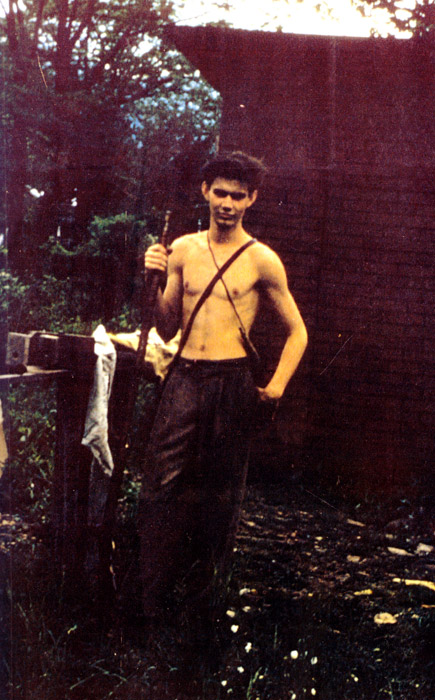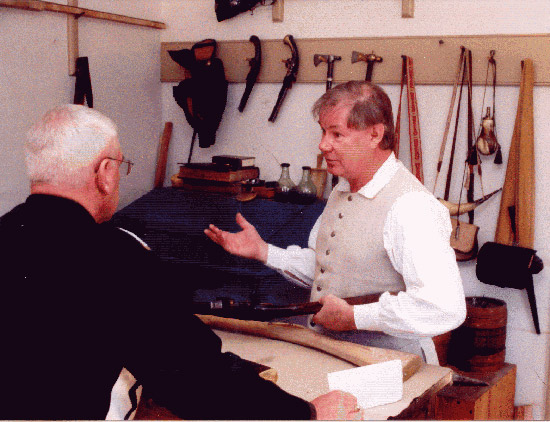|
Wallace Gusler is a native Virginian who grew up in Fort Lewis
Hollow at the foot of Fort Lewis Mountain in Roanoke, County.
Living practically in the shadow of Andrew Lewis’s French and
Indian War fort could have been what sparked Wallace’s interest
in the frontier and longrifles but it wasn’t. Despite their
name, Fort Lewis School largely ignored this local history.
Instead it was the “arrowheads” that he found in plowed fields
that inspired Wallace’s fascination first with Indians, then
with the Virginia frontier.
In about 1954 Wallace’ father, Lester Gusler, decided to replace
a family longrifle burned in a house fire years earlier. He
purchased a full-stocked, iron-mounted, .32 caliber, squirrel
rifle and, when he had trouble getting the old percussion rifle
to fire, Wallace asked if he could try it. Mr. Gusler handed it
over and, as they say, “the rest is history.” While many events
come together to shape the direction of a person’s life, having
that rifle to shoot and hunt with had a huge influence on
Wallace and this writer, who was at the time his neighbor.
Like most folks living in the country, the Guslers had a small
workbench in one of their outbuildings and a few hand tools so
Wallace had a place to start work. By age 14 (1956), he had made
his first muzzleloader, a cherry stocked percussion pistol.
There were, of course, no “how to” books or videos so he began
to visit with some of the old timers in the area, picking their
brains for information and studying any old rifles they had.
Sorting out the folklore from the facts was mostly a matter of
experimentation—one fellow swore that mainsprings had to be
quenched in blood.
About 1957, Wallace converted the tar paper sided chicken coup
shown in the picture into a workshop. After tearing out the
roosting poles and shoveling out the droppings he added glass
windows and a concrete floor. Although Wallace worked long hours
in this shop, he was not yet a full time gunsmith. He also
worked at his father’s saw mill, tended the garden and
livestock, and ran on the high school track team. In the summer,
hardly a day went by that there was not some excuse to fire a
few shots from the shop into the sawdust pile backstop or at any
blackbirds foolish enough to land within range. In the fall
Hickory Flats in Buck Hollow was a favorite place to camp and
squirrel hunt. There was mountain humor in both those place
names because the Flats were on a steep mountain side and the
last buck was probably killed before WWI. In those days you
could hunt for a week just to find a deer track on Fort Lewis
Mountain.
It was in 1958 that Wallace first visited Howard Sites, a
gunsmith in Covington, VA. Howard was the last working gunsmith
in family of Virginia gunsmiths that began with George Sites in
the Shenandoah Valley about 1785. Howard worked primarily on
modern rifles but his shop held a collection of longrifles and
barrels of old parts. Wallace got his first original carved
rifle in trade for work he did for Howard. That fall Wallace
killed his first buck with a longrifle made by J. J. Henry about
1830.
Soon word of the young gunsmith’s work spread and people began
to bring in all types of guns for him to repair or restock. At
one time $15 would get a new stock for an L.C. Smith double
barrel shotgun and $100 a longrifle—with Wallace supplying all
the parts. His shop also became a hang out for the other
neighbor boys, and men, interested in guns and hunting. In about
1959 the Roanoke Times printed an article about Wallace and his
work. One of those who read the article and came to see the work
was Robyn Hale. A geology student at nearby Virginia Tech, Robyn
was from Tennessee and helped Wallace connect with a larger
circle of shooters and builders. Wallace went to shoots at
Charlie Heffner’s near Franklin, TN and at Leonard Meadow’ shop
in Shady Springs, WV. At the time neither Wallace nor Robyn knew
how their friendship would end up changing Wallace’s life, but
more on that later.
By 1960 a couple of the boys hanging around the shop had also
started building rifles. A revival regional style had developed
that incorporated features of the antique rifles available for
study and what could be seen in the occasional magazine article.
Because many of the old rifles brought in for repair and in
local collections were made in the area, the new guns made in
Wallace’s shop had a strong Virginia feel. This “Fort Lewis
Holler” school of rifle design evolved before we ever saw Joe
Kindig’s groundbreaking 1960 book Thoughts on the Kentucky Rifle
in it’s Golden Age.
Cash was scarce and that made parts hard to come by. Old barrels
were either “freshed out” or re-bored for use. Stocks were made
from boards sawn at his father’s steam powered mill. There were
no good quality flintlocks available so Wallace began to forge
his own. As I remember, most of the guards and buttplates came
from Dixie Gun Works. Fueled by R.C. Colas, Moon Pies and, at
night, country music from WCKY out of Cincinnati, Wallace became
a rifle maker.

About 1962 in front of old chicken coop workshop.
In 1962 Robyn Hale was working for the Virginia Highway
Department and was assigned to a project in Surry County, VA.
Surry is just across the James River from Colonial Williamsburg
so Robyn came to visit. He learned that there was interest in
adding a gunsmith to the small Craft Shops program. Who better
than Wallace?
After a failed attempt for Wallace to meet with Earl Soles, Jr.,
the Assistant Director of Craft Shops, at the Richmond gun show,
Robyn borrowed Wallace’s latest rifle and brought it to
Williamsburg. The rifle was examined, disassembled, and examined
some more. Soon Earl was on his way to Southwest Virginia to
meet Wallace. After an interview that revealed not only a talent
for gun building but also a passionate interest in Virginia
history, Wallace was offered a job. He would start in the
blacksmith shop while a gunsmith shop was set up. He came to
Williamsburg late in 1962. About a year later he moved to the
gunsmith shop and in 1964 was named Master Gunsmith.
One of the goals that were evolving for the Colonial
Williamsburg’s trades program in the 1960s was for each shop to
rediscover and preserve the skills and period technology of
their trade. Rediscovery of lost processes and techniques
requires both research and experimentation. In the museum world
this combined process is now known as experimental or “above
ground” archaeology.
When he came to Williamsburg, Wallace could make every part of a
rifle by hand, except the barrel. He set out to rediscover the
process of hand forging rifle barrels. Written descriptions of
the process existed and a few old timers remembered seeing it
done in the 1890s, but no one could be found who had actually
done the work. Examination of old rifle barrels revealed that
most had a single seam running lengthwise instead of the spiral
seam found on pattern welded shotgun barrels. Acid etching also
showed that most were butt, rather than lap, welded. Knowing how
something was done and actually being able to do it are two very
different things. By 1964 Wallace was ready to begin teaching
himself to forge weld rifle barrels.
In 1965, I had completed my first year of college and Wallace
offered me a summer job. I eagerly accepted because it was a
chance to get paid for doing what I considered my hobby and to
help him learn how to weld rifle barrels. (Twenty years later,
when asked how I came to work in Williamsburg, I would tell
visitors that it was a hobby that got out of hand.) That summer
we were faced with an interesting situation. The shop was open
to the public from 9 a.m. until 7 p.m. and during the day our
time was divided between working on guns and talking to visitors
about the trade. The forge was next door in the blacksmith shop
and in constant use making items for sale. Wallace and I had to
experiment with barrel welding after both shops closed.
Fortunately using the facilities and tools after hours was
permitted and even encouraged as a way for apprentices to build
their skills.
Because visitors were often on the street, we had to work with
the doors and shutters of the blacksmith shop closed. That
required us to hang up jury-rigged electric lights—three naked
150-watt bulbs cast harsh shadows. If you have ever been to
Williamsburg in the summer you know that the heat and humidity
can be intense, both often in the ninety’s. Working at a forge
in a closed shop was a physical challenge but we did it
enthusiastically on many nights that summer. It was a time of
excitement and discovery.
We had no wrought iron and had to use mild steel for those first
efforts. That made the welding more difficult because steel
tends to burn if even slightly overheated. I remember picking up
a partially welded skelp only to see half of my barrel left in
the fire. In a careless moment I had burned it. Lesson learned,
managing the fire is as important as knowing how to hammer.
There were other setbacks, but, by summer’s end, Wallace had the
hand-forged barrel that he used to build his first totally
hand-made rifle later that year.
Wallace had become the first person in modern times to recreate
all the processes of making a rifle with 18th-century
technology. In [Terri look up month] of 1966 John Bivins wrote
an article about Wallace and that first handmade rifle for
Muzzle Blasts. During the winter of 1967 Colonial Williamsburg
documented making a complete rifle in the film The Gunsmith of
Williamsburg. Released in 1968, this 58-minute film is still the
best selling video of the trades series.
In 1972 Wallace left the Gunsmith Shop to become the Curator of
Mechanical Objects. Two years later he became Curator of
Furniture. In January of 1985, Wallace transferred to the
Department of Conservation as Chief Conservator, Furniture and
Arms, and in June of 1987, he was promoted to Director of
Conservation. Although he was away from the shop, Wallace
continued to teach classes on carving, engraving and arms
conservation and to build rifles at his home shop. He also
expanded his work to include architectural carving, making
period furniture and doing sculpture. And, all the while,
research and photography continued for a book on Virginia
gunsmiths and their work.
In the spring of 1994 Wallace returned to the position of Master
Gunsmith, working part of each week in the shop and part on his
Virginia gunsmith book. As his expected retirement date began to
draw near Wallace was given a leave of absence to work full time
on his book. The rifle whose photos accompany this article is
the last all handmade rifle Wallace produced for the Colonial
Williamsburg Gunsmith Shop. It was completed last spring.

After over forty years with Colonial Williamsburg, Wallace will
retire this winter. Retirement does not mean he plans to
quite working. There are many projects to be completed,
including his book. You will also find him teaching classes at
the NMLRA Gunsmithing Seminar at Western Kentucky University. In
anticipation of having more time for doing custom work Wallace
has opened a booth on rifle maker’s row at Friendship. Stop by
and say hello to the man whose work lead the way in the revival
of traditional rifle making and whose research and writing
continues to expand our knowledge of the rifle and the culture
in which it was used.
(top) |
![]()